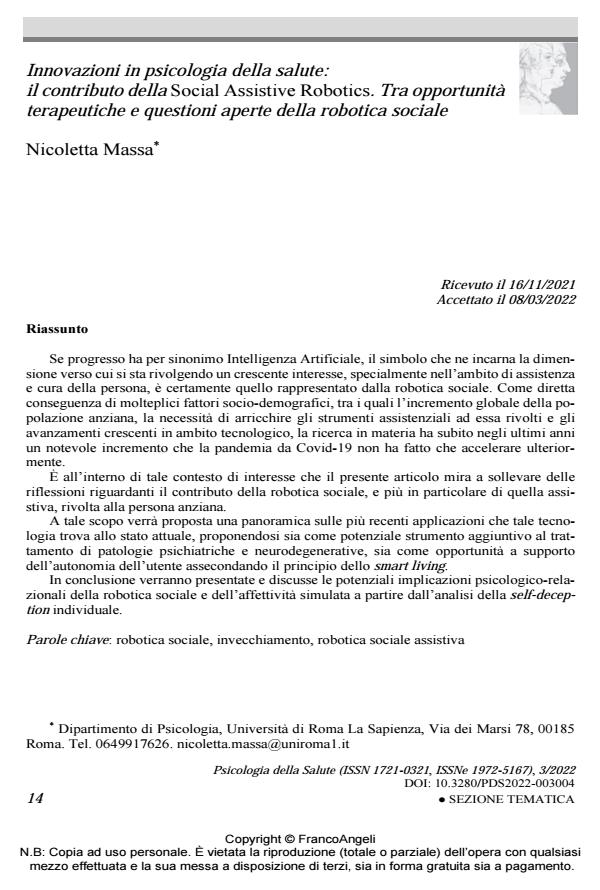Innovazioni in psicologia della salute: il contributo della Social Assistive Robotics. Tra opportunità terapeutiche e questioni aperte della robotica sociale
Titolo Rivista PSICOLOGIA DELLA SALUTE
Autori/Curatori Nicoletta Massa
Anno di pubblicazione 2022 Fascicolo 2022/3
Lingua Italiano Numero pagine 14 P. 14-27 Dimensione file 221 KB
DOI 10.3280/PDS2022-003004
Il DOI è il codice a barre della proprietà intellettuale: per saperne di più
clicca qui
Qui sotto puoi vedere in anteprima la prima pagina di questo articolo.
Se questo articolo ti interessa, lo puoi acquistare (e scaricare in formato pdf) seguendo le facili indicazioni per acquistare il download credit. Acquista Download Credits per scaricare questo Articolo in formato PDF

FrancoAngeli è membro della Publishers International Linking Association, Inc (PILA)associazione indipendente e non profit per facilitare (attraverso i servizi tecnologici implementati da CrossRef.org) l’accesso degli studiosi ai contenuti digitali nelle pubblicazioni professionali e scientifiche
Se progresso ha per sinonimo Intelligenza Artificiale, il simbolo che ne incarna la dimensione verso cui si sta rivolgendo un crescente interesse, specialmente nell’ambito di assistenza e cura della persona, è certamente quello rappresentato dalla robotica sociale. Come diretta conseguenza di molteplici fattori socio-demografici, tra i quali l’incremento globale della popolazione anziana, la necessità di arricchire gli strumenti assistenziali ad essa rivolti e gli avanzamenti crescenti in ambito tecnologico, la ricerca in materia ha subito negli ultimi anni un notevole incremento che la pandemia da Covid-19 non ha fatto che accelerare ulteriormente. È all’interno di tale contesto di interesse che il presente articolo mira a sollevare delle riflessioni riguardanti il contributo della robotica sociale, e più in particolare di quella assistiva, rivolta alla persona anziana. A tale scopo verrà proposta una panoramica sulle più recenti applicazioni che tale tecnologia trova allo stato attuale, proponendosi sia come potenziale strumento aggiuntivo al trattamento di patologie psichiatriche e neurodegenerative, sia come opportunità a supporto dell’autonomia dell’utente assecondando il principio dello smart living. In conclusione verranno presentate e discusse le potenziali implicazioni psicologico-relazionali della robotica sociale e dell’affettività simulata a partire dall’analisi della self-deception individuale.
Parole chiave:robotica sociale, invecchiamento, robotica sociale assistiva
Nicoletta Massa, Innovazioni in psicologia della salute: il contributo della Social Assistive Robotics. Tra opportunità terapeutiche e questioni aperte della robotica sociale in "PSICOLOGIA DELLA SALUTE" 3/2022, pp 14-27, DOI: 10.3280/PDS2022-003004